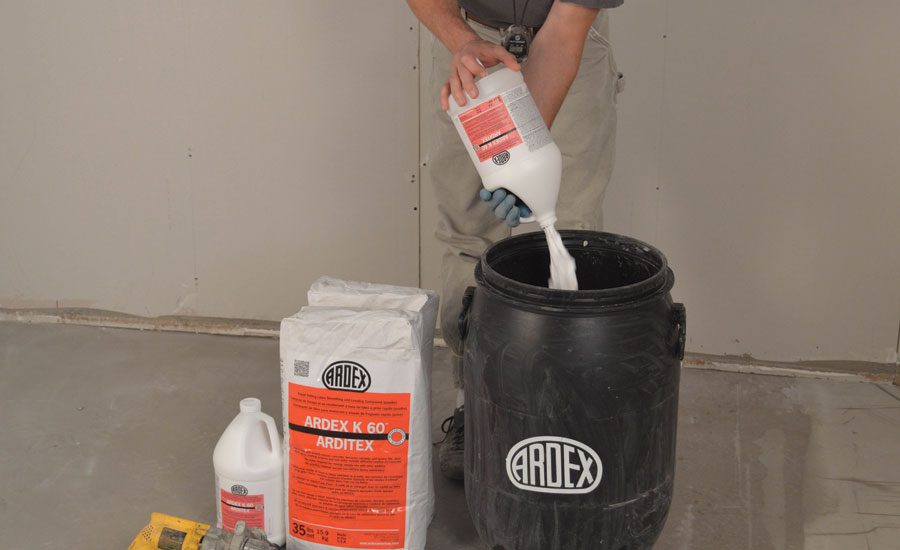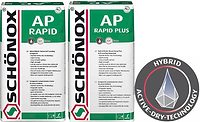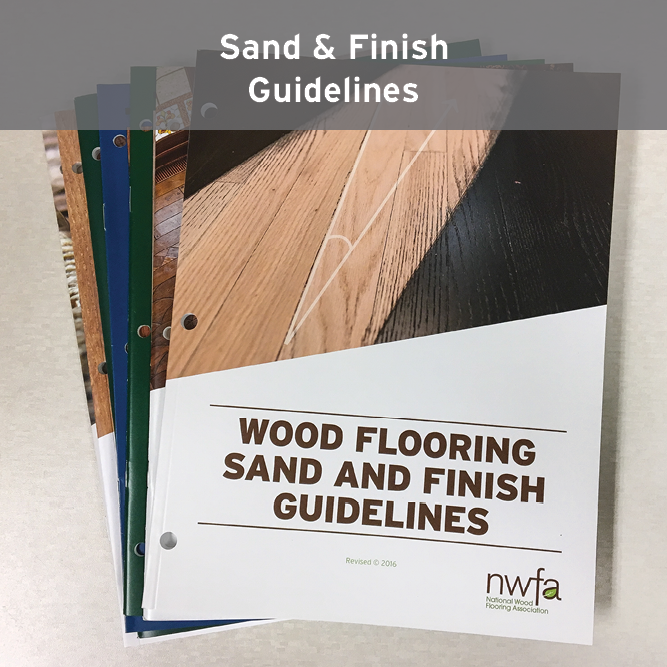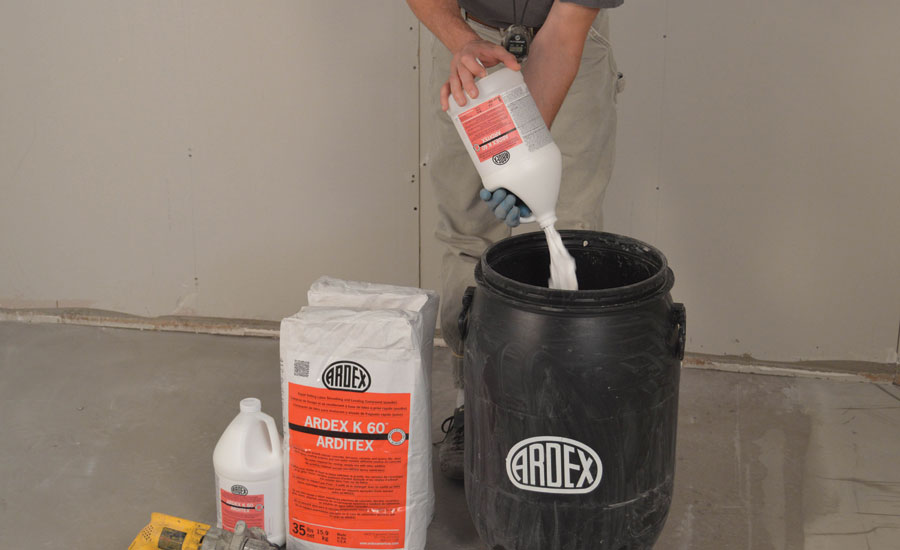Flooring Underlayment Systems: Self-Levelers, Patches and More


USG Quik-Top is a gypsum-based underlayment that can also be used as a wear surface.

Stauf’s Levelseal ULC 500 Universal Leveling Compound.





With the increasing prevalence of floating luxury vinyl floors and larger, thinner ceramic tile, the need for a flat subfloor is becoming that much greater. That need has led to an explosion of self-leveling underlayments on the market. A range of subfloor prep product manufacturers discuss their latest offerings, technologies and common misconceptions about working with the materials.
Article Index:
Patch vs. self-leveler
Using a patch vs. a self-leveler comes down to choice, according to Daniel Tallman, HPS Schonox business development. “A simple job with slight imperfections in a floor is almost always addressed by patching. However, a large skimming job with patch usually requires skimming and sanding. This can be labor-intensive and dusty. If the jobsite is an existing healthcare facility, a dust-reduced leveler might be desired instead.”
When applying a self-leveler, subfloor prep is essential, he added. “It should consist of vacuuming, removing easily friable materials, priming and putting down foam tape to guard against overflow. That should take up 75% of prep time. The other 25% is spent pouring.”
Brett Fleury, USG product marketing manager—performance flooring, substrates and specialties division, said contractors will often choose self-levelers when they need a deeper pour. “Some patches will go up to a 1/2-inch. Once you get beyond that with a patch you may see cracking and even debonding, with significant thickness variations.”
David Ford, vice president of sales and marketing for Stauf USA, said choosing a patch or a leveler comes down to the demands of the project. “What am I going over? What can I accommodate? Is the overall compression strength good? Can I go over existing adhesives or floor coverings without having to tear them up?”
According to Seth Pevarnik, Ardex director of technical service, choosing between a patch or self-leveler really comes down to labor. “Featheredge to 1/8-inch you would typically choose a trowelable patch. However, if your whole floor needs 1/8-inch or greater, it would be extremely labor intensive to use a patch. Ultimately, 99 times out of 100 you are going to get a floor that’s much flatter if you self-level it.”
New technologies
Steve Taylor, Custom Building Products director of technical and architectural marketing, said new technologies have created “a generation of products that require very little subfloor preparation. In many cases, there are options that no longer require shot blasting the subfloor before installing a self-leveling underlayment. Changes in raw materials allow us to formulate floor preparation materials that bond better to subfloors.”
W.F. Taylor’s Kristine Elledge, marketing specialist, said her company has launched Acous-Tec liquid underlayment engineered for sound reduction in floating floor installations. “Through further research and development, we were able to include multifunctional attributes like moisture control, patching and leveling.”
She noted the sound reduction, with ratings of IIC 71 and STC 67, far surpass building code requirements. The liquid underlayment offers other benefits as well. “Since it’s a liquid it doesn’t just cover cracks but really fills them. The liquid will completely surround the imperfection and eliminate it up to 1/8-inch and will level up to 1/8-inch in 10 feet.”
Yoni Feldman, international marketing manager for Laticrete, said his company offers three self-leveling products: the Laticrete Supercap system, the NXT line and the Drytek Levelex line. “The Laticrete Supercap system is the most unique delivery system out there, providing smooth, flat and dry subfloors in the quickest time.”
Tallman commented that the newest technology in self-leveling underlayment is synthetic gypsum, found in Schonox’s AP and APF products. “Schonox AP can cure most interior subfloor problems by going over existing materials in a cleaner, more environmentally friendly way.” He added that APF “can create an extremely flat, flexible subfloor with a high PSI.”
Fleury said USG’s portfolio features both gypsum-based (Durock Multi-Use, Proflow and Quik-Top) and cement-based (Durock Speed, Ultracap and Ecocap). “Gypsum-based products are really coming back because of a reduced amount of floor prep, without any need to scarify or shot blast.”
He calls the company’s Quik-Top “a very unique engineered cement. The base is a gypsum binder, it’s self-drying and allows you to put a floor covering over it in 15 hours. The material is extremely hard. We offer it in white and gray. The gray you can polish to create a concrete look to the surface. The white allows you to topically stain it. In the past, people would think using gypsum as a wear surface was impossible.”
Stauf’s Levelseal ULC500 Universal Leveling Compound is one of the company’s latest products. “You pour it onto the subfloor, and not only do you have leveling but some nice STC/IIC ratings and moisture mitigation as well. It’s a nice product straight out of the bucket,” Ford said.
Ardex’s new K 10 is a reactivatable underlayment. “Typically, self-levelers have a flow time of 10 to 15 minutes,” Pevarnik explained. “After that, any mark you make in the self-leveler will remain—the product no longer has the ability to heal itself. With Ardex K 10, you can simply run a spiked roller through the material and it becomes workable again. Even if it’s been on the floor for 15 to 20, even 25 minutes, you can run a spiked roller through it and it will heal itself. So you always have fresh material going into fresh material.”
Greg Hunsicker, Ardex’s manager of business analysis and subfloor prep category, highlighted the range of delivery systems available for self-leveling underlayments. “You have your traditional barrel mix; the Ardex Rover which is a barrel on wheels so you don’t hurt your back dragging 50 pounds of material; pumps; Cube trucks and 18-wheelers that pump out ridiculous amounts of material. You can do the whole floor in such a speedy, efficient way.”
Tom Plaskota, H.B. Fuller Construction Products technical support manager, said the company recently reformulated its premium self-leveling underlayment Tec EZ Level. “This is a cement-based, pourable and pumpable underlayment. Its new formula offers longer working times, better flow and a fast drying time.”
He added that more products are entering the marketplace with the goal of meeting tight installation schedules. “Our products cure quickly, so surface preparation and tiling can be done on the same day. Similarly, more ready-to-use products are entering the market. These allow contractors to save on mixing time.”
Tips and common mistakes
Jeff Johnson, MAPEI’s business manager for surface preparation products and floor covering installation systems, said knowing the water ratio for self-levelers and cement-based preparation products is critical. “More water is not better. Self-levelers, skim coats and patches—based on cement or gypsum raw materials—are designed to provide specific performance properties based on an engineered amount of water. If the contractor adds more or less water than prescribed, the performance properties can shift radically.”
He also cautions installers to be mindful of the temperature. “The best performances come when the mix water is at room temperature. Cold or hot water will significantly change the set time for these types of products. That is why some contractors in the hot days of summer will actually ice down their mix water. Hot water will accelerate set times where cold water will slow them down.”
Johnson added, “The last possible misconception I can think of is even though the product says it self-levels, it almost always requires a little help getting to its final form. Don’t forget to gauge them out with a rake and touch them up with a smoother to get the best finish.”
Feldman said to never overwater a self-leveling underlayment. “Contractors don’t realize that while overwatering seems to help with the flow, it actually causes the finished product to be weaker and prone to cracking and shrinkage problems.”
He added that subfloor prep is crucial. “Priming is a big key, and so is making sure the substrate is clean and free of any bond-breakers or contaminants.”
Taylor stressed the importance of following manufacturer instructions to the letter. “It is important to use the right water-to-powder ratio, and that temperature ranges and pot life are closely monitored.”
He added that despite the name, self-levelers will not simply level themselves out. “It is still necessary to spread the product across the entire floor and distribute the material evenly. It is much easier to get a level surface compared to a traditional mortar bed, but there is still some effort needed.”
Pevarnik stated that underlayment will act differently in cold weather and warm weather. “Optimal self-leveling would be in a controlled environment, but we realize that’s not always the case. So it’s about understanding the conditions. Pour first thing in the morning when the slab will be the coolest in the summer months. Make sure the bags are inside as well, whether in the summer or the winter. You don’t want the sun beating down on the bags, and in the winter if the slab gets too cold (less than 50 degrees F) the chemical reaction of the self-leveling material could be slowed and have adverse effects.”
He offers one other word of caution. “Just because the product has the word ‘level’ does not mean you are going to have a dead-level floor. Most applications just require a substrate to be flat and smooth, and a self-leveler will provide that.”
Hunsicker believes the biggest misconception is that some people think self-levelers will be hard to use. “The guys who are still patching instead of leveling are gun-shy. If they follow the instructions, it’s not difficult to use, and from a labor standpoint it’s easier and you get a better product in the end.”
Tallman stated a common misconception is comparing synthetic gypsum to traditional gypsum. “Synthetic gypsum is a different quality grade of product than ordinary gypsum.”
Fleury noted that the stigma around gypsum is finally going away. “Gypsum products are not inferior to cement products. The industry is starting to learn more about the benefits and features of these technologies.”
Ford said there is a misconception among installers that self-leveling compounds are basically the same from brand to brand. “That’s incorrect. Each of these products have different compression strengths, different requirements. Many installers do not seem to want to follow the directions on the bag, but they’re there for a reason. Make sure to read and follow them.”
A few thoughts on mortars
Mark Pennine, Ardex technical manager for tile and stone installation systems, said when working with large and thin tiles, installers need to do their homework. “Lots of installers don’t have experience installing these types of tiles, and they will do their due diligence and go to the mortar manufacturers to look at their recommendations. Even guys who install it every day understand the need for that.”
He said his company offers a self-drying technology in the mortar mix. “There is no evaporation of moisture, which really reduces the shrinkage of the product. You can use a cement-based thin-set to install very sensitive stones.”
Pennine cautioned, “After you add the required amount of water to your mix, never add more water. You can remix it, but do not add more water.”
Looking for a reprint of this article?
From high-res PDFs to custom plaques, order your copy today!












